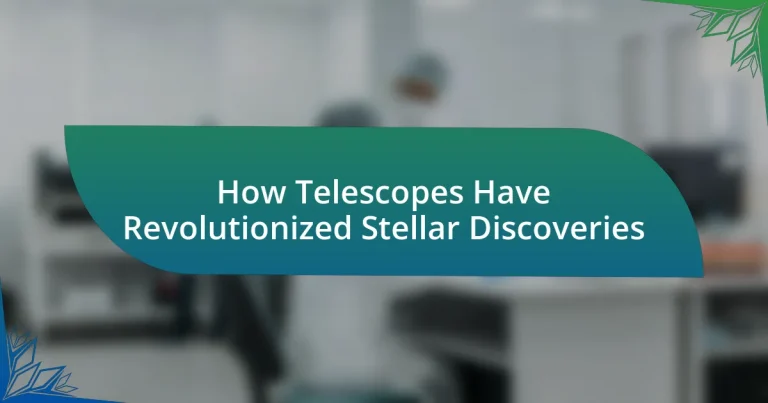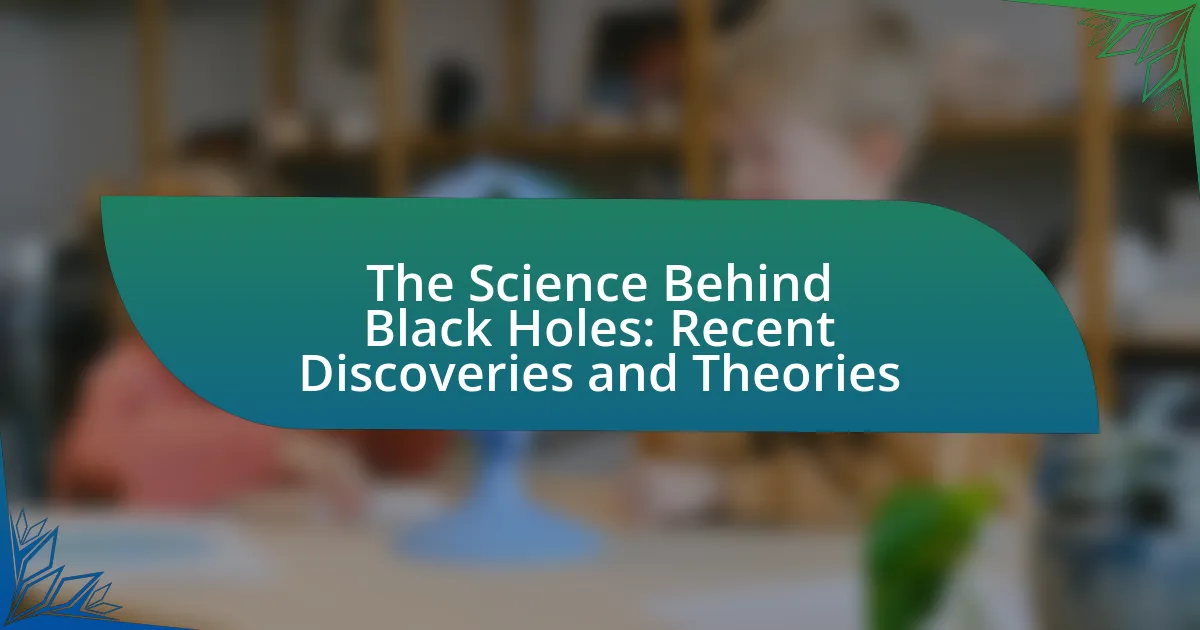Telescopes have revolutionized our understanding of the universe by enabling detailed observations of celestial objects, leading to significant astronomical discoveries. The article outlines the historical evolution of telescopes, from the early refracting designs of Galileo to modern advancements like the Hubble Space Telescope and adaptive optics technology. Key topics include the impact of telescopes on the discovery of exoplanets, the study of cosmic phenomena such as black holes and dark matter, and the role of different types of telescopes in enhancing our knowledge of the universe. Additionally, the article discusses future prospects for telescope technology and the challenges faced in their development, emphasizing their essential role in advancing astronomy.
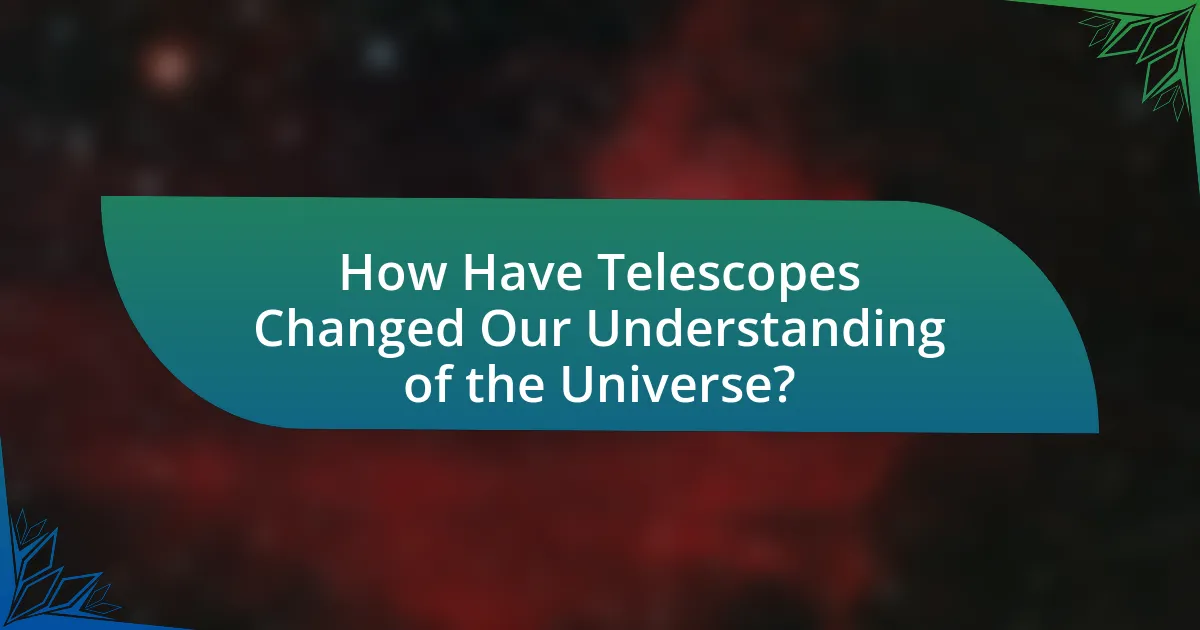
How Have Telescopes Changed Our Understanding of the Universe?
Telescopes have fundamentally transformed our understanding of the universe by enabling the observation of celestial objects beyond the capabilities of the naked eye. The invention of the refracting telescope in the early 17th century allowed astronomers like Galileo to discover moons orbiting Jupiter, demonstrating that not all celestial bodies revolve around the Earth. This challenged the geocentric model of the universe and supported the heliocentric theory proposed by Copernicus.
Subsequent advancements, such as the development of the reflecting telescope by Isaac Newton, further enhanced observational capabilities, leading to the discovery of new planets, stars, and galaxies. The Hubble Space Telescope, launched in 1990, has provided unprecedented clarity and depth in astronomical images, revealing the existence of exoplanets and the expansion of the universe, quantified by Edwin Hubble’s observations of redshift.
These advancements in telescope technology have not only expanded the catalog of known celestial objects but have also deepened our understanding of cosmic phenomena, such as black holes and dark matter, fundamentally altering our perception of the universe’s structure and evolution.
What are the key advancements in telescope technology?
Key advancements in telescope technology include the development of adaptive optics, which corrects atmospheric distortion in real-time, and the construction of space-based telescopes like the Hubble Space Telescope, which eliminates atmospheric interference altogether. Adaptive optics systems, first implemented in the 1990s, enhance image clarity by adjusting the telescope’s optics based on atmospheric conditions, allowing for sharper images of celestial objects. Space-based telescopes, launched since the late 20th century, provide unobstructed views of the universe, leading to significant discoveries such as the acceleration of the universe’s expansion. These advancements have fundamentally transformed our understanding of the cosmos by enabling more precise observations and discoveries.
How have these advancements improved our ability to observe celestial bodies?
Advancements in telescope technology have significantly enhanced our ability to observe celestial bodies by increasing resolution, sensitivity, and the range of wavelengths we can detect. For instance, the development of adaptive optics allows ground-based telescopes to correct for atmospheric distortion, resulting in clearer images of distant stars and galaxies. Additionally, space telescopes like the Hubble Space Telescope operate outside Earth’s atmosphere, providing unobstructed views and capturing data across ultraviolet, visible, and infrared wavelengths. This capability has led to groundbreaking discoveries, such as the identification of exoplanets and the observation of cosmic phenomena like black holes and supernovae, fundamentally expanding our understanding of the universe.
What role do different types of telescopes play in stellar discoveries?
Different types of telescopes play crucial roles in stellar discoveries by utilizing various wavelengths of light to observe celestial objects. Optical telescopes, for instance, capture visible light, allowing astronomers to study stars, planets, and galaxies in detail, leading to significant findings such as the discovery of exoplanets through transit methods. Radio telescopes, on the other hand, detect radio waves emitted by celestial bodies, enabling the study of phenomena like pulsars and cosmic microwave background radiation, which provides insights into the early universe. Infrared telescopes, such as the Hubble Space Telescope, reveal cooler objects obscured by dust, facilitating the discovery of star-forming regions and distant galaxies. Each type of telescope contributes uniquely to our understanding of the universe, as evidenced by the diverse range of astronomical phenomena they help uncover.
Why are telescopes considered essential tools in astronomy?
Telescopes are considered essential tools in astronomy because they enable the observation of distant celestial objects, allowing astronomers to gather crucial data about the universe. By magnifying light from stars, galaxies, and other astronomical phenomena, telescopes facilitate the study of their properties, such as composition, distance, and movement. For instance, the Hubble Space Telescope has provided insights into the expansion rate of the universe and the existence of exoplanets, significantly advancing our understanding of cosmic evolution.
How do telescopes enhance our knowledge of distant galaxies?
Telescopes enhance our knowledge of distant galaxies by allowing astronomers to observe light from these galaxies across various wavelengths, revealing their composition, structure, and dynamics. For instance, the Hubble Space Telescope has provided high-resolution images and spectra that have led to discoveries about galaxy formation and evolution, such as the identification of dark matter and the measurement of the universe’s expansion rate. These observations are crucial for understanding the physical processes occurring in galaxies billions of light-years away, thus significantly advancing our comprehension of the universe.
What discoveries have been made possible by telescopes?
Telescopes have enabled significant discoveries in astronomy, including the identification of exoplanets, the observation of distant galaxies, and the detection of cosmic microwave background radiation. For instance, the Kepler Space Telescope has confirmed thousands of exoplanets, expanding our understanding of planetary systems beyond our own. Additionally, the Hubble Space Telescope has provided detailed images of galaxies billions of light-years away, revealing the universe’s structure and evolution. Furthermore, telescopes have played a crucial role in detecting cosmic microwave background radiation, which supports the Big Bang theory and offers insights into the universe’s early conditions. These discoveries underscore the transformative impact of telescopes on our comprehension of the cosmos.
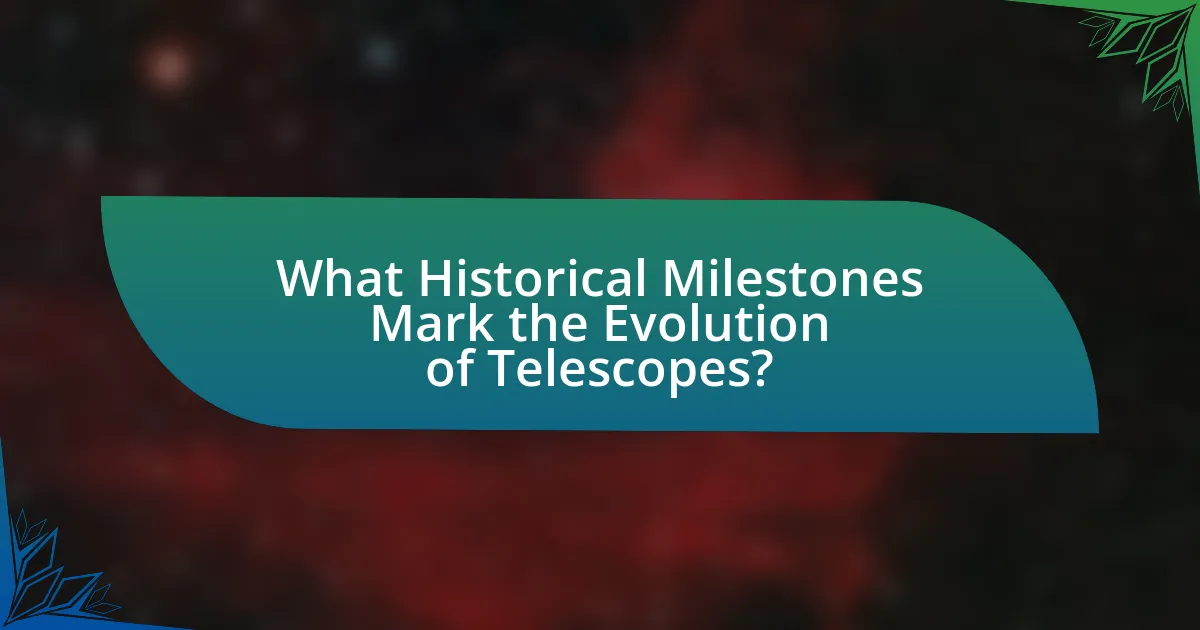
What Historical Milestones Mark the Evolution of Telescopes?
The evolution of telescopes is marked by several key historical milestones. The first significant milestone occurred in 1608 when Hans Lippershey, a Dutch spectacle maker, created the first practical telescope, allowing for magnified views of distant objects. This invention was quickly followed by Galileo Galilei’s improvements in 1610, which enabled him to make groundbreaking astronomical observations, including the moons of Jupiter and the phases of Venus.
In 1671, Isaac Newton developed the reflecting telescope, utilizing mirrors instead of lenses, which reduced chromatic aberration and improved image clarity. The 18th century saw the construction of larger refracting telescopes, such as the one built by William Herschel in 1781, which he used to discover the planet Uranus.
The 20th century introduced the advent of radio telescopes, with the first operational one built by Karl Jansky in 1932, expanding the field of astronomy beyond visible light. The Hubble Space Telescope, launched in 1990, marked a significant leap in observational capabilities, providing unprecedented clarity and depth in astronomical imaging.
These milestones collectively illustrate the progressive advancements in telescope technology, which have fundamentally transformed our understanding of the universe.
How did early telescopes contribute to astronomical discoveries?
Early telescopes significantly advanced astronomical discoveries by enabling astronomers to observe celestial objects in greater detail than ever before. For instance, Galileo Galilei’s use of a telescope in the early 17th century led to the discovery of Jupiter’s four largest moons, providing evidence that not all celestial bodies orbit the Earth, which challenged the geocentric model of the universe. Additionally, Johannes Kepler’s improvements to telescope design allowed for more precise observations, leading to the formulation of the laws of planetary motion. These advancements laid the groundwork for modern astronomy, demonstrating the critical role early telescopes played in expanding our understanding of the universe.
What were the limitations of early telescopes?
Early telescopes had significant limitations, primarily due to their optical design and materials. The refracting telescopes, which used lenses, suffered from chromatic aberration, causing colors to blur and images to distort. Additionally, the quality of glass and lens crafting techniques in the 17th century were inadequate, leading to poor image resolution and clarity. Furthermore, early telescopes had limited light-gathering ability, restricting observations of faint celestial objects. These constraints hindered astronomers’ ability to make detailed observations and discoveries, impacting the advancement of astronomy during that period.
Who were the key figures in the development of early telescopes?
The key figures in the development of early telescopes include Hans Lippershey, Galileo Galilei, and Johannes Kepler. Hans Lippershey, a Dutch spectacle maker, is credited with the invention of the first practical telescope in 1608, which he demonstrated to the Dutch government. Galileo Galilei improved upon Lippershey’s design in 1609, creating a telescope that allowed for significant astronomical observations, such as the moons of Jupiter and the phases of Venus. Johannes Kepler further advanced telescope design by introducing the Keplerian telescope in 1611, which utilized a convex lens for the eyepiece, enhancing magnification and field of view. These contributions were pivotal in transforming astronomical observation and understanding.
What innovations have shaped modern telescopes?
Innovations that have shaped modern telescopes include adaptive optics, digital imaging sensors, and large segmented mirrors. Adaptive optics technology allows telescopes to compensate for atmospheric distortion, resulting in clearer images of celestial objects. Digital imaging sensors, such as CCDs (Charge-Coupled Devices), have replaced traditional photographic plates, enabling faster and more sensitive data collection. Large segmented mirrors, like those used in the Keck Observatory, enhance light-gathering capability and resolution, allowing astronomers to observe fainter and more distant objects. These advancements collectively enhance the precision and capability of telescopes, significantly contributing to our understanding of the universe.
How has the introduction of space telescopes changed our observations?
The introduction of space telescopes has significantly enhanced our observations of the universe by providing clearer and more detailed images of celestial objects. Unlike ground-based telescopes, space telescopes operate above Earth’s atmosphere, eliminating atmospheric distortion and light pollution, which allows for more accurate data collection. For instance, the Hubble Space Telescope has captured high-resolution images of distant galaxies, nebulae, and exoplanets, revealing structures and phenomena that were previously undetectable. This capability has led to groundbreaking discoveries, such as the acceleration of the universe’s expansion and the identification of exoplanets in habitable zones, fundamentally altering our understanding of cosmology and planetary science.
What technological advancements have improved telescope imaging?
Technological advancements that have improved telescope imaging include adaptive optics, digital imaging sensors, and advanced spectroscopy. Adaptive optics systems correct for atmospheric distortion in real-time, allowing ground-based telescopes to achieve clarity comparable to space telescopes. Digital imaging sensors, such as CCDs (Charge-Coupled Devices), provide high sensitivity and resolution, enabling the capture of faint astronomical objects. Advanced spectroscopy techniques, including multi-object spectroscopy, enhance the ability to analyze the composition and movement of celestial bodies, leading to more detailed observations. These innovations collectively enhance the quality and precision of astronomical imaging, facilitating significant discoveries in the field.
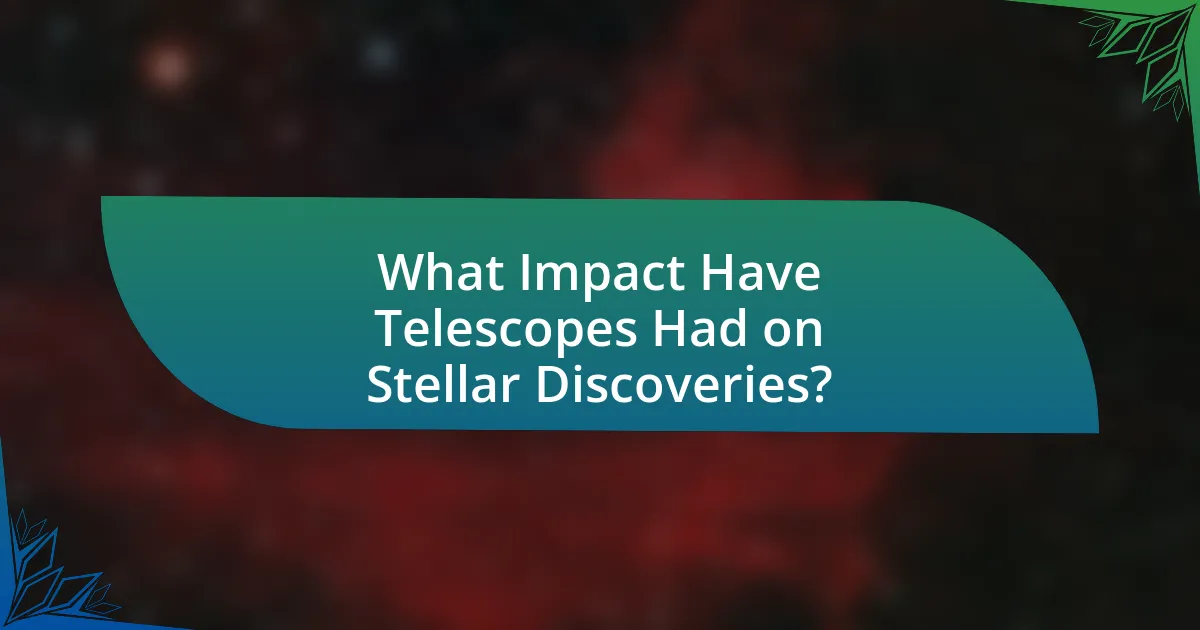
What Impact Have Telescopes Had on Stellar Discoveries?
Telescopes have significantly advanced stellar discoveries by enabling astronomers to observe celestial objects with unprecedented clarity and detail. The invention of the refracting telescope in the early 17th century allowed for the first detailed observations of planets and stars, leading to the identification of Jupiter’s moons by Galileo Galilei in 1610. Furthermore, the development of the Hubble Space Telescope in 1990 has provided deep-field images revealing thousands of galaxies, contributing to our understanding of the universe’s expansion and the existence of dark energy. These advancements illustrate how telescopes have transformed our knowledge of stellar phenomena, allowing for discoveries such as exoplanets and the precise measurement of stellar distances through parallax.
How have telescopes contributed to the discovery of exoplanets?
Telescopes have significantly contributed to the discovery of exoplanets by enabling precise measurements of stellar light variations caused by orbiting planets. The transit method, utilized by telescopes like Kepler, detects dips in brightness as a planet passes in front of its host star, leading to the identification of thousands of exoplanets. For instance, Kepler’s mission, launched in 2009, confirmed over 2,300 exoplanets by monitoring the brightness of more than 150,000 stars. Additionally, radial velocity measurements from ground-based telescopes have revealed the gravitational influence of planets on their stars, further confirming their existence. These methods have collectively transformed our understanding of planetary systems beyond our own.
What methods do telescopes use to detect exoplanets?
Telescopes use several methods to detect exoplanets, primarily including the transit method and the radial velocity method. The transit method involves monitoring the brightness of a star over time; a decrease in brightness indicates that a planet may be passing in front of the star, blocking some of its light. This method has been successfully employed by missions such as NASA’s Kepler Space Telescope, which confirmed thousands of exoplanets through this technique. The radial velocity method, on the other hand, detects the gravitational influence of a planet on its host star, causing the star to wobble slightly. This wobble can be measured through shifts in the star’s spectral lines, a technique that has been instrumental in discovering many exoplanets, including those in the habitable zone. Both methods have been validated through extensive observations and data analysis, confirming their effectiveness in exoplanet detection.
What are some notable exoplanets discovered by telescopes?
Some notable exoplanets discovered by telescopes include Kepler-186f, Proxima Centauri b, and HD 209458 b. Kepler-186f, identified by NASA’s Kepler Space Telescope in 2014, is significant as it is located in the habitable zone of its star and is similar in size to Earth. Proxima Centauri b, discovered in 2016, orbits the closest star to the Sun and is also within the habitable zone, raising interest in its potential for life. HD 209458 b, detected in 1999, was the first exoplanet observed transiting its star, providing critical insights into the atmospheres of exoplanets. These discoveries underscore the capabilities of telescopes in expanding our understanding of planetary systems beyond our own.
What role do telescopes play in understanding cosmic phenomena?
Telescopes are essential tools for understanding cosmic phenomena as they allow astronomers to observe distant celestial objects and events in various wavelengths of light. By capturing data across the electromagnetic spectrum, telescopes enable the study of the universe’s structure, composition, and evolution. For instance, the Hubble Space Telescope has provided insights into the expansion of the universe and the existence of dark energy by observing distant galaxies and their redshifts. Additionally, radio telescopes have been crucial in detecting cosmic microwave background radiation, which offers evidence for the Big Bang theory. These observations contribute to our knowledge of fundamental astrophysical processes and the nature of the cosmos.
How do telescopes help in studying black holes and neutron stars?
Telescopes help in studying black holes and neutron stars by enabling astronomers to observe the electromagnetic radiation emitted from these objects, which provides critical data about their properties and behaviors. For instance, telescopes equipped with advanced sensors can detect X-rays and gamma rays emitted by accretion disks around black holes or the intense radiation from neutron stars, allowing scientists to infer their mass, spin, and other characteristics. Observations from the Event Horizon Telescope, which captured the first image of a black hole’s event horizon in 2019, exemplify how telescopes can provide direct evidence of black holes’ existence and their influence on surrounding matter. Additionally, gravitational wave observatories, which utilize telescope technology, have detected mergers of neutron stars, offering insights into their formation and the nature of gravity.
What insights have telescopes provided about the Big Bang and cosmic evolution?
Telescopes have provided critical insights into the Big Bang and cosmic evolution by enabling the observation of cosmic microwave background radiation and distant galaxies. The detection of cosmic microwave background radiation, first observed by the COBE satellite in 1992, supports the Big Bang theory by revealing the afterglow of the universe’s hot, dense state approximately 380,000 years after the event. Additionally, telescopes like the Hubble Space Telescope have captured images of galaxies formed shortly after the Big Bang, allowing astronomers to study their formation and evolution over billions of years. These observations have confirmed the expansion of the universe and provided evidence for dark energy, which influences cosmic evolution.
What are the future prospects for telescope technology?
The future prospects for telescope technology include advancements in adaptive optics, increased sensitivity to faint objects, and the development of space-based observatories. Adaptive optics will enhance image clarity by compensating for atmospheric distortion, allowing ground-based telescopes to achieve resolutions previously only possible in space. Increased sensitivity will enable telescopes to detect exoplanets and distant galaxies, expanding our understanding of the universe. Space-based observatories, such as the James Webb Space Telescope, will provide unprecedented views of the cosmos, free from atmospheric interference, facilitating discoveries in astrophysics and cosmology. These advancements are supported by ongoing research and investment in astronomical technology, indicating a promising future for telescope capabilities.
How might upcoming telescopes change our understanding of the universe?
Upcoming telescopes, such as the James Webb Space Telescope and the Extremely Large Telescope, are poised to significantly enhance our understanding of the universe by providing unprecedented resolution and sensitivity to observe distant celestial objects. These advanced instruments will enable astronomers to study the formation of stars and galaxies in greater detail, revealing insights into the early universe and the processes that govern cosmic evolution. For instance, the James Webb Space Telescope is designed to detect infrared light, allowing it to observe objects that are too faint or too distant for current telescopes, thus uncovering previously hidden aspects of cosmic history.
What challenges do astronomers face in telescope development?
Astronomers face several challenges in telescope development, including technological limitations, funding constraints, and environmental factors. Technological limitations arise from the need for advanced materials and precision engineering to create instruments capable of capturing high-resolution images across various wavelengths. Funding constraints often hinder the development of large-scale projects, as significant financial resources are required for construction, maintenance, and operation. Environmental factors, such as light pollution and atmospheric disturbances, can also affect the performance of telescopes, necessitating the development of adaptive optics and remote locations for optimal observation. These challenges collectively impact the ability of astronomers to enhance our understanding of the universe.
What are some best practices for using telescopes in stellar observations?
Best practices for using telescopes in stellar observations include ensuring proper alignment, using appropriate filters, and selecting optimal observing conditions. Proper alignment of the telescope is crucial for accurate tracking of celestial objects, as misalignment can lead to blurry images. Utilizing filters can enhance visibility of specific wavelengths, allowing for clearer observation of stars and other celestial phenomena. Additionally, observing during stable atmospheric conditions, such as on nights with low turbulence, significantly improves image quality and detail. These practices are supported by the fact that astronomers have consistently achieved better results when following these guidelines, leading to more precise data collection and analysis in stellar research.
